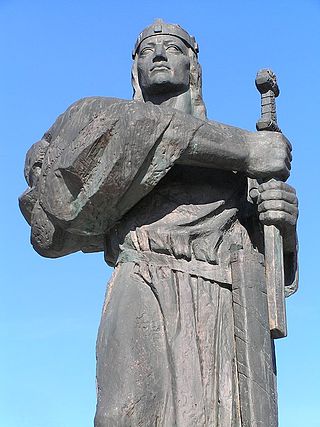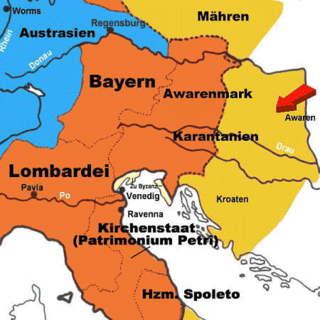The history of Slovakia dates back to the findings of ancient human artifacts. This article shows the history of the country from prehistory to the present day.

Year 846 (DCCCXLVI) was a common year starting on Friday of the Julian calendar.

Carloman was a Frankish king of the Carolingian dynasty. He was the eldest son of Louis the German, king of East Francia, and Hemma, daughter of a Bavarian count. His father appointed him governor of Carantania in 856, and commander of southeastern frontier marches in 864. Upon his father's death in 876 he became king of Bavaria. He was appointed by King Louis II of Italy as his successor, but the Kingdom of Italy was taken by his uncle Charles the Bald in 875. Carloman only conquered it in 877. In 879 he was incapacitated, perhaps by a stroke, and abdicated his domains in favour of his younger brothers: Bavaria to Louis the Younger and Italy to Charles the Fat.

Great Moravia, or simply Moravia, was the first major state that was predominantly West Slavic to emerge in the area of Central Europe, possibly including territories which are today part of the Czech Republic, Slovakia, Hungary, Austria, Germany, Poland, Romania, Croatia, Serbia, Ukraine and Slovenia. The formations preceding it in these territories were Samo's tribal union and the Pannonian Avar state.

Svatopluk I or Svätopluk I, also known as Svatopluk the Great, was a ruler of Great Moravia, which attained its maximum territorial expansion during his reign.

Rastislav or Rostislav was the second known ruler of Moravia (846–870). Although he started his reign as vassal to Louis the German, the king of East Francia, he consolidated his rule to the extent that after 855 he was able to repel a series of Frankish attacks. Upon his initiative, brothers Cyril and Methodius, sent by the Byzantine Emperor Michael III in 863, translated the most important Christian liturgical books into Slavonic. Rastislav was dethroned by his nephew Svatopluk I of Moravia, who handed him over to the Franks. He was canonized by the Eastern Orthodox Church in 1994 and is also known as Saint Rastislav.

Mojmir II was a member of the House of Mojmir and since 894 the last known ruler of Great Moravia. He probably died in the beginning of the 10th century in a battle against the Magyars.

Mojmir I, Moimir I or Moymir I was the first known ruler of the Moravian Slavs (820s/830s–846) and eponym of the House of Mojmir. In modern scholarship, the creation of the early medieval state known as Great Moravia is attributed either to his or to his successors' expansionist policy. He was deposed in 846 by Louis the German, king of East Francia.

The Principality of Nitra, also known as the Duchy of Nitra, was a West Slavic polity encompassing a group of settlements that developed in the 9th century around Nitra, in present-day Slovakia. Its history remains uncertain because of a lack of contemporary sources. The territory's status is subject to scholarly debate: some modern historians describe it as an independent polity that was annexed either around 833 or 870 by the Principality of Moravia, while others say that it was under the influence of the neighbouring West Slavs from Moravia from its inception.

Kocel was a ruler of the Slavs in Lower Pannonia. He was an East Frankish vassal titled comes (count), and is believed to have ruled between 861 or 864 and 876.

Zalavár is a village in south-western Hungary, located in Zala County. It is located around 9 km (6 mi) southwest of Lake Balaton.

The March of Pannonia or Eastern March was a frontier march of the Carolingian Empire, named after the former Roman province of Pannonia and carved out of the preceding and larger Avar March.

The Avar March was a southeastern frontier province of the Frankish Empire, established after successful Frankish campaigns and conquests of Avarian territories along the river Danube, to the east from the river Enns, in what is today Lower Austria and northwestern Hungary. Since the Frankish conquest in the late 8th century, there were several administrative changes in those regions. Territory along the river Danube, from the river Enns to the Vienna Woods, was ruled directly, as a frontier extension (march) of the Frankish Bavaria, while regions further to the east, up to the river Rába, were initially designated to remaining Avarian princes, under the Frankish supreme rule. During the 820s and 830s, additional administrative changes were made in the wider region of Frankish Pannonia, inhabited mainly by Pannonian Slavs. Territories of the remaining Avarian princes were fully incorporated, and Avars eventually disappeared from the region.

Early Slavs settled in the eastern and southern parts of the former Roman province of Pannonia. The term Lower Pannonia was used to designate those areas of the Pannonian Plain that lie to the east and south of the river Rába, with the division into Upper and Lower inherited from the Roman terminology.

The Hungarian conquest of the Carpathian Basin, also known as the Hungarian conquest or the Hungarian land-taking, was a series of historical events ending with the settlement of the Hungarians in Central Europe in the late 9th and early 10th century. Before the arrival of the Hungarians, three early medieval powers, the First Bulgarian Empire, East Francia, and Moravia, had fought each other for control of the Carpathian Basin. They occasionally hired Hungarian horsemen as soldiers. Therefore, the Hungarians who dwelt on the Pontic-Caspian Steppe east of the Carpathian Mountains were familiar with what would become their homeland when their conquest started.

The Christianization of Moravia refers to the spread of the Christian religion in the lands of medieval Moravia.

The Archbishopric of Moravia was an ecclesiastical province, established by the Holy See to promote Christian missions among the Slavic peoples. Its first archbishop, the Byzantine Methodius, persuaded Pope John VIII to sanction the use of Old Church Slavonic in liturgy. Methodius had been consecrated archbishop of Pannonia by Pope Adrian II at the request of Koceľ, the Slavic ruler of Pannonia in East Francia in 870.
Alternative theories of the location of Great Moravia propose that the core territory of "Great Moravia", a 9th-century Slavic polity, was not located in the region of the northern Morava River. Moravia emerged after the fall of the Avar Khaganate in the early 9th century. It flourished during the reign of Svatopluk I in the second half of the century, but collapsed in the first decade of the 10th century. "Great Moravia" was regarded as an archetype of Czechoslovakia, the common state of the Czechs and Slovaks, in the 20th century, and its legacy is mentioned in the preamble to the Constitution of Slovakia.
The Merehani was a Slavic tribe mentioned by the Bavarian Geographer. They are often connected to the Moravians (Marhari), although some scholars believe that the tribe was separate.
Radbod was the East Frankish prefect of the Eastern March, the Bavarian frontier towards the Slavs, appointed in 833. He had been appointed the office after Louis the German's conquest in 828, and subsequent Christianization of the Moravians (828–33). In 833, according to the Conversio Bagoariorum et Carantanorum, a Slavic prince, Pribina, had been "driven across the Danube by Mojmir, duke of the Moravians", and fled to Radbod in East Francia around 833. Radbod introduced him to King Louis the German, who ordered that Pribina should be "instructed in the faith and baptized", and that he serve with his followers in Radbod's army. Before long, however, Radbod and Pribina fell out, and the latter, fearing for his life, fled with his son Koceľ to the First Bulgarian Empire, and then to Lower Pannonia ruled by a Slavic duke, Ratimir. Since Lower Pannonia was part of Radbod's prefecture, Ratimir's harboring of Pribina was tantamount to rebellion, therefore, in 838, Louis the German sent Radbod at the head of a large Bavarian army to crush Ratimir, but Pribina and his followers took refuge with the count of Carniola, Salacho. In short time the latter brokered a reconciliation between Radbod and Pribina, and Louis solved the ongoing instability by appointing Pribina as his faithful dux with lands in around the Zala river. Radbod held contacts with Rastislav, ruler of the Moravians, who had long posed a danger to Bavaria. According to the Annals of St-Bertin, in 853 Charles the Bald, king of West Francia, bribed the Bulgarians to ally with the Slavs and together attack Louis the German's kingdom. In the course of the Bulgarian–Moravian attack, Louis the German deposed Radbod in 854 for infidelity, after an uprising. Radbod then formed a rebel alliance with Rastislav. In 855, Rastislav (Rastiz) rebelled, and Carloman was made prefect in Radbod's place in 856. Carloman's 858 campaign forced Rastislav to make peace.


















